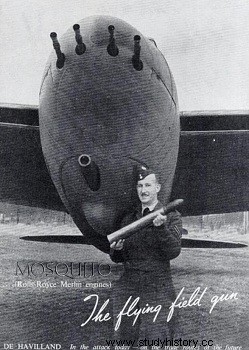
Although scholar weapons are effective. there was never enough. But, against the relatively fragile building that is a submarine, a simple weapon can be as effective as a complicated weapon. This is what the Royal Air Force thought, which had requested, in 1938, a 40 mm automatic cannon for aircraft. The RAF thought of using it against both submarines and aircraft. Two guns were manufactured, the "S" model by Vickers-Armstrong and the "B H" model by Rolls-Royce. The "S" gun was intended for the RAF and widely used during the campaigns in the Middle East, and the Royal Navy was equipped with the "BH" gun with which it mainly armed small coastal defense vessels, but also some of its aircraft.
A big cannon for the “Mosquitos”
The 40 mm gun having proved less effective than had been hoped, it was proposed in 1943 to mount the 57 mm army anti-tank gun on aircraft, firing a 6-pounder shell. The Molins company had developed a very efficient automatic loading system, so that it could be used by combat tanks, and by the navy instead of the "BH". The weapon and its automatic loader were installed in the bomb bay of a Mosquito aircraft; the first tests having been satisfactory. 12 of these aircraft were equipped with the "6-pound type M gun", its now official name.
But at the time when the "M" type gun was installed on board these 12 aircraft , the interest of the staffs focused on rockets, considered as a simpler weapon; they were thus the only planes provided with this gun. RAF 248 Squadron, stationed at Predannack in Cornwall, received these aircraft in October 1943, which achieved their first success on 7 November. A Mosquito piloted by Lieutenant Bonnet of the Canadian RAF attacked U-123 near Lorient with its 6-pounder gun. The submarine was able to return to its base after the attack; but it was learned after the war that her thick hull had been breached in seven places, that a petty officer had been killed and two men wounded.
One would have thought that, after using the army anti-tank guns, 2-pounder and 6-pounder, the RAF would be interested in the new 17-pounder anti-tank gun. But there is no trace of such interest. On the other hand, the RAF passed, at a stroke, to the largest caliber ever used by the army for a conventional anti-tank gun, that is to say 94 mm. This gun, which never entered service, was, in fact, the anti-aircraft piece of the same caliber mounted on a two-wheeled carriage of a field gun. It fired a 32-pound projectile that could pass through armor at a speed of 900 m/s. Had it arrived in time, it would undoubtedly have been one of the most powerful anti-tank guns of the war. But it was too late and its manufacture was abandoned. Yet at the start of his career, when he had barely passed the stage of the model, the RAF Armament Studies Directorate had begun to embark on calculations. It foresaw that with a new version of the Molins autoloader, it could be used as an air-to-air as well as air-to-surface weapon; but the first problem was to prevent his shot from demolishing the plane.
The solution consisted in reducing the shock of recoil by equipping the barrel with a very elaborate muzzle brake, designed by a certain Galliot. Galliot had escaped from France in 1940; he was working in England as a weapons engineer and his theories on the muzzle brake were far ahead of his time. Unfortunately his projects, although very valid and giving excellent results on prototypes, were almost impossible to carry out in series; more than one manufacturer withdrew. However, we managed to design and manufacture one of these Galliot muzzle brakes for the 32-pounder gun. But the war ended before it was installed on an aircraft. In order to put the theory into practice, and to gather useful information for the future, we decided to install the gun anyway and try it out... and it worked! Galliot's muzzle brake gave all the results expected of it; a Mosquito plane took to the air with the 1,800 kg gun and magazine and fired a shot. The proof having been made, it was then scrapped!
Galliot muzzle brake
Invention that made possible the installation on an aircraft of the 32-pound shell gun. The Galliot muzzle brake was a complicated and difficult device to mass-produce. It is seen here mounted on a 6-pound shell gun:the spiral grooves allow the deflection of the gases from the explosion, which then exert a thrust on the front, which opposes the recoil of the piece.
